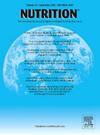Impact of a multicomponent food-as-medicine intervention on behavioral and mental health outcomes for patients with and without food insecurity
IF 3.2
3区 医学
Q2 NUTRITION & DIETETICS
引用次数: 0
Abstract
Background
Increasingly, food-as-medicine (FAM) programs are being implemented as a strategy for improving the health of patients. However, current policies limit nutrition resources to patients with specific chronic condition diagnoses and do not include food insecurity as a qualifying condition.
Objective
Explore the impact of Recipe4Health (R4H), a multicomponent FAM intervention, on behavioral and mental health outcomes in patients with and without food insecurity.
Methods
Patients (n = 336) with diet-related chronic conditions and/or food insecurity were referred to R4H, which included 16-weekly produce deliveries and behavioral intervention sessions. Food security status was assessed using the U.S. Department of Agriculture 6-item survey. Outcomes included vegetable/fruit intake, physical activity (PA) and mental health. Within- and between-group pre-post changes were assessed using repeated-measures linear mixed-effects models, adjusting for baseline.
Results
The majority of patients had one or more chronic conditions (96%) and identified as food insecure (62%). Patients with food insecurity experienced significant increases in daily servings of vegetables/fruit (+0.38 ± 0.15; P = 0.01) and minutes of moderate-to-vigorous PA per week (+28.94 ± 9.84; P < 0.01). Patients with food security did not experience significant increases in vegetables/fruit (P = 0.09) or PA (P = 0.06). Food-insecure and food-secure patients both experienced significant improvements in loneliness, anxiety, and depressive symptoms from baseline (P < 0.01 for all). Between-group differences were observed only for anxiety, where patients with food security experienced significant improvements in anxious symptoms compared to food-insecure patients (–1.24 [–2.33, –0.14]; P = 0.03).
Conclusion
Policymakers may consider expanding eligibility criteria to include food insecurity as an independent qualifying condition for FAM.
多成分食物即药物干预对有无食物不安全患者行为和心理健康结果的影响
越来越多的食物即药物(FAM)计划被作为一种改善患者健康的战略而实施。然而,目前的政策将营养资源限制在患有特定慢性病诊断的患者身上,并且没有将粮食不安全作为合格条件。目的探讨多组分FAM干预(Recipe4Health, R4H)对有和无食物不安全患者行为和心理健康结局的影响。方法伴有饮食相关慢性疾病和/或食物不安全的患者(n = 336)被纳入R4H,其中包括16周生产分娩和行为干预。食品安全状况是根据美国农业部的6项调查来评估的。结果包括蔬菜/水果摄入量、身体活动(PA)和心理健康。使用重复测量线性混合效应模型评估组内和组间的前后变化,并根据基线进行调整。结果大多数患者患有一种或多种慢性疾病(96%),并确定为食品不安全(62%)。食物不安全患者的每日蔬菜/水果摄入量显著增加(+0.38±0.15;P = 0.01)和每周中高强度PA分钟数(+28.94±9.84;P & lt;0.01)。有食物保障的患者在蔬菜/水果(P = 0.09)或PA (P = 0.06)方面没有显著增加。食物不安全患者和食物安全患者在孤独感、焦虑和抑郁症状方面均较基线有显著改善(P <;0.01)。仅在焦虑方面观察到组间差异,与食物不安全患者相比,食物安全患者的焦虑症状有显著改善(-1.24 [-2.33,-0.14];P = 0.03)。结论决策者可以考虑扩大合格标准,将粮食不安全作为FAM的独立合格条件。
本文章由计算机程序翻译,如有差异,请以英文原文为准。
求助全文
约1分钟内获得全文
求助全文
来源期刊

Nutrition
医学-营养学
CiteScore
7.80
自引率
2.30%
发文量
300
审稿时长
60 days
期刊介绍:
Nutrition has an open access mirror journal Nutrition: X, sharing the same aims and scope, editorial team, submission system and rigorous peer review.
Founded by Michael M. Meguid in the early 1980''s, Nutrition presents advances in nutrition research and science, informs its readers on new and advancing technologies and data in clinical nutrition practice, encourages the application of outcomes research and meta-analyses to problems in patient-related nutrition; and seeks to help clarify and set the research, policy and practice agenda for nutrition science to enhance human well-being in the years ahead.
 求助内容:
求助内容: 应助结果提醒方式:
应助结果提醒方式:


